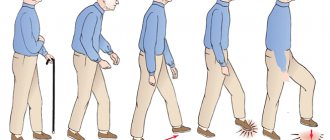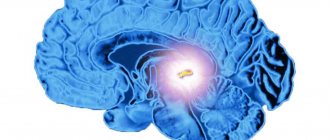Among the symptoms indicating the presence of neurological disorders, the most common are cognitive disorders, which arise as a result of pathological changes in the structure and functioning of the brain.
This problem mainly occurs in older people. The high incidence of cognitive disorders in this category of patients is explained by age-related changes in the body, which negatively affect the functioning of the central nervous system.
Cognitive impairment refers to a decrease in memory, mental capacity and other intellectual functions. Such changes are identified by comparing current indicators with the individual norm.
Cognitive brain functions - what is it?
Cognitive (cognitive) functions are the most complex processes occurring in the brain. They provide a rational perception of the surrounding reality, an understanding of the events occurring around a person. Through the cognitive abilities of the brain, people find connections between themselves and what they encounter in everyday life.
Cognitive activity consists of the following functions:
- Memory . This term refers to the special ability of the brain to assimilate incoming information, store it and, if necessary, reproduce it.
- Gnosis . This function is responsible for the perception of incoming information from the outside world. Gnosis refers to the brain’s ability to process data and synthesize the simplest sensations coming from all senses into holistic structures.
- Speech . This concept refers to a person’s ability to exchange previously acquired information through statements.
- Praxis . This term refers to a person's ability to acquire and retain new motor skills and then use them in everyday life.
- Intelligence . It refers to the ability to compare incoming information, find commonalities and differences. A person’s ability to make judgments and draw various conclusions on a particular issue depends on the level of intelligence.
Problems with memory and intelligence occur when any part of the brain is damaged. Violations of other cognitive functions occur when certain parts of the central nervous system are damaged (parietal, frontal, temporal and other lobes).
Three stages of cognitive impairment
Such violations are usually classified according to the severity of the consequences. Cognitive disorders may be of the following nature:
- With mild disorders, minor changes are observed that fall within the established norms for a specific age group. Such disorders do not create problems for a person in everyday life. At the same time, people themselves or those around them may notice such changes.
- Moderate by changes in cognitive functions that go beyond existing norms. However, such violations do not affect the person’s condition and do not cause maladjustment in his everyday life. Moderate disorders usually manifest themselves as problems in performing complex intellectual tasks.
- The most dangerous type of cognitive personality disorder is dementia, or dementia . This condition is accompanied by significant changes in memory and other brain functions. Such disorders are pronounced and have a direct impact on a person’s daily life.
Why does cognitive dysfunction develop?
The etiological factors for the occurrence of cognitive disorders are classified into two groups: functional, which are also called temporary, and organic, provoked by a certain pathology in the brain.
Functional factors
Temporary cognitive impairments are not associated with changes in brain structures and therefore are not permanent. The etiological factors of this group are considered to be: psycho-emotional stress, prolonged exposure to stress, physical overload and the accumulation of a large number of negative emotions.
Cognitive deficits in this group can develop at any age and are not considered dangerous to humans. Symptoms of disorders become less pronounced or disappear completely after the cause of the problem is eliminated.
Organic pathologies
Cognitive disorders of an organic nature are more common in the adult population and can be caused by impaired blood supply to the brain, traumatic brain injury, metabolic or age-related changes.
Causes of cognitive deficits due to impaired blood supply include:
- Hypertension.
- Vascular atherosclerosis.
- Pathologies of the cardiovascular system such as coronary heart disease or heart attack.
- Strokes.
Pathological metabolic disorders are caused by:
- endocrine diseases: hypothyroidism and diabetes;
- kidney or liver failure;
- reduced intake or incomplete absorption of vitamin B12 and folic acid;
- frequent drinking of alcohol;
- smoking;
- taking drugs and certain medications.
Age-related changes in the brain are caused by atrophy, the causes of which may be Alzheimer's disease or Parkinson's syndrome.
Complex of provoking factors
There are more than 10 different factors that can lead to cognitive disorders of brain function. The most common cause of such disorders is Alzheimer's disease. This pathology is accompanied by the gradual death of brain neurons, as a result of which its individual functions are suppressed.
The first and most striking sign of Alzheimer's disease is memory loss. At the same time, motor activity and other cognitive functions remain within normal limits for a long time.
In addition to Alzheimer's disease, a decrease in a person's intellectual capabilities is observed in the following neurodegenerative pathologies:
Quite often, cognitive disorders can manifest themselves in vascular diseases of the brain. These include:
Basically, dementia and other forms of psychoneurological disorders are caused by a combination of vascular pathology and circulatory failure in the brain. The risk group for developing such complications includes people who have been diagnosed with:
- atherosclerosis;
- hypertension;
- arterial hypertension.
Cognitive deficits can also develop with the following diseases (although with much lower risks than in the previous case):
Among the probable causes of the development of psychoneurological disorders are severe poisoning and long-term use of psychotropic substances. Head injuries can also lead to dementia and mild impairment of brain function.
Cognitive impairment of vascular origin in elderly patients
The demographic situation in our country shows similar dynamics. According to the State Statistics Committee of the Russian Federation, in Russia in 2021, out of 146,880,400 Russians, 37,362,600 (25.4%) are representatives of the older generation (60+), that is, 25.4%.4
People began to live longer. This is largely the merit of medicine and healthcare... which turned into a kind of boomerang. Along with the increase in life expectancy, the incidence of illness and the burden on medical institutions increases - after all, with age, a person, as a rule, gradually accumulates chronic diseases, and the ability to adapt to both exogenous and endogenous influences decreases. Doctors of all specialties are well aware of the complexity of managing elderly patients, special approaches and algorithms for their treatment.
Neurologists are among them. Among a number of diseases, the frequency of which increases with increasing life expectancy, are neurodegenerative dementias and cerebrovascular diseases (acute cerebrovascular accidents, chronic vascular diseases of the brain), the frequent consequences of which are cognitive impairment (CI) of varying severity. Moreover, in elderly patients, many chronic progressive diseases of the brain (BM) of a neurodegenerative or vascular nature are accompanied by multifunctional CIs, when there is simultaneous depression of several (or all) cognitive functions: decreased memory (especially for current events), impaired attention, concentration and ability to quickly orientation in a changing environment, slowness of thinking, rapid exhaustion during intense mental work, narrowing the range of interests.
Table. Cognitive functions
| Gnosis | The ability to recognize objects by sensory perception; violation of gnosis - agnosia or, with a lesser severity of violations, dysgnosis; a patient with agnosia sees an object, can describe it, but does not recognize it, despite the absence of primary sensory disorders. |
| Memory | The ability to capture, store and repeatedly reproduce received information; symptoms of memory loss - amnesia or, with less severe disorders, dysmnesia - decreased ability to remember. |
| Intelligence | The ability to analyze information, identify similarities and differences, general and particular, main and secondary, the ability to abstract, solve problems, build logical conclusions. |
| Speech | Ability to understand spoken language and express thoughts verbally; absence or disorder of already formed speech - aphasia or, with a lesser severity of disorders, dysphasia. |
| Praxis | The ability to learn and retain a variety of motor skills, which are based on automated series of movements; violations of prakis - apraxia or, with less severity of violations, dyspraxia; a patient with apraxia cannot perform a particular action due to the loss of a skill (“forgot how”), despite the absence of paresis, coordination disorders and other primary motor disorders. |
Drawing. Brain Aging, Continuum (BP Lochart, PJ Lestage, 2003)5
Cognitive impairment . Cognitive (cognitive) functions are the most complex functional system of the brain. It was thanks to them that a biological being became not just Homo sapiens, but a Personality. And that is why disorders in the functioning of this system in recent decades have become one of the most significant and complex problems of neurology.
Cognitive impairment (or vascular cognitive impairment) is a clinically heterogeneous group of neuropsychological syndromes in nature and severity. Often they become the first and important symptoms in dyscirculatory encephalopathy and other diseases of the brain. Non-dementia (mild and moderate severity) in the early stages of CI can progress to vascular dementia (impairment of higher cortical functions, primarily regulatory, leading to social, everyday and work maladjustment).
Table. Descriptive characteristics of cognitive impairment6
| Cognitive impairment | general description |
| Agnosia (dysgnosis) | Loss (impairment) of the ability to recognize information coming from the senses, despite the preservation of primary sensitivity. |
| Amnesia (dysmnesia) | Loss (impairment) of the ability to remember, store and/or reproduce information obtained as a result of individual experience. |
| Aphasia (dysphasia) | Loss (impairment) of the ability to verbally communicate, including understanding spoken speech and/or constructing one’s own speech utterance. |
| Apraxia (dyspraxia) | Loss (impairment) of the ability to perform purposeful motor acts, despite the absence of primary motor disorders (paralysis, paresis, EPS). |
| Impaired executive functions | One or more of the following violations:
|
Clinical characteristics of CN:
- slowness of cognitive processes (bradyphrenia);
- intellectual disorders;
- violations of visual-spatial gnosis and praxis;
- memory disorders;
- combined with emotional, motor, sensory disorders and other manifestations of DE.
The severity and nature of vascular CI depend on the location and volume of brain damage. An important role in their formation and development is played by damage to the deep parts of the white matter of the brain and basal ganglia, leading to disruption of the connections of the frontal lobes and subcortical structures (disconnection phenomenon) and determining the features of the clinical picture.7 Microangiopathies (changes in the system of small vessels of a functional and structural nature).8-9
Table. Classification of cognitive impairment by severity according to N.N. Yakhno (2005, 2006)10-11
| Mild cognitive impairment (MCI) | Mild cognitive impairment (MCI) | Severe cognitive impairment |
| A decrease in cognitive abilities compared to a higher premorbid level of an individual, which formally remains within the average age norm or deviates slightly from it. Usually reflected in the patient’s complaints, but does not attract the attention of others. Does not cause difficulties in everyday life, even in its most complex forms. | Decrease in cognitive abilities, clearly beyond the age norm. It is reflected in the patient’s complaints and attracts the attention of others. Does not lead to significant difficulties in everyday life, although it may interfere with the most complex types of intellectual activity. | A decrease in cognitive abilities, which leads to significant difficulties in everyday life, partial or complete loss of independence and autonomy. |
Causes of cognitive impairment:
- Alzheimer's disease and other neurodegenerative diseases;
- vascular diseases of the brain;
- traumatic brain injury;
- brain tumors and other space-occupying processes, chronic intracranial hypertension syndrome;
- neuroinfections and demyelinating diseases;
- dysmetabolic encephalopathy (with somatic, endocrine diseases, exogenous intoxications);
- emotional disorders.
For mild cognitive impairment of vascular origin:12
- vascular risk factors (hypercholesterolemia, arterial hypertension) can lead to vascular damage to the brain or enhance the neurodegenerative changes that underlie Alzheimer's disease (AD);
- clinical features: presence of frontal symptoms and extrapyramidal disorders (also frontal type);
- progression of cognitive impairment from MCI/MCI to dementia within 1 year in approximately 15% of patients, within 3 years in 50% of patients, and after 6 years in 80%;13
- prognosis – the mortality rate of patients with MCI is 2.4 times higher than that of people of the same age group in the population.
Epidemiology. According to foreign researchers, the prevalence of MCI among people over 60 years of age is 12–18%: about a third of all cases of cognitive impairment in older people who do not reach the stage of dementia.14 With age, this figure increases - up to 25% in people 80–89 years old.15 Patients with a number of cardiovascular pathologies demonstrate slightly different indicators. Thus, CIs, nonspecific in nature and not severe in severity, are observed in almost 50% of patients with occlusion of the internal carotid artery and ipsilateral transient ischemic attacks.16 In patients who have had a stroke, mild CIs of vascular origin are observed in 30–70% of cases.17
But these are the results obtained by domestic neurologists in the epidemiological study PROMETHEUS (2004–2005): the prevalence of CI in Russia among 3210 outpatient neurological patients (33 cities of 30 regions of the Russian Federation) was 73%. Subjectively perceived disorders were identified in 14% of patients, MCI and MCI – in 44%, dementia – in 25%.18 However, experts note that in this study only simple (and not sensitive enough to milder CI) screening tests were used.
However, the actual prevalence rates of MCI and MCI are most likely higher. Elderly people and their loved ones do not always pay attention to the first manifestations of CI - slight forgetfulness corresponds to the wave, in their opinion, age and is not worthy of the attention of a doctor. And doctors sometimes consider these problems as an age-related norm.
Diagnostics. But it is the non-dementia (or pre-dementia) CIs that the doctor should pay special attention to. And the point is not only in their wide prevalence and frequent combination with many somatic diseases, in the treatment of which cognitive disorders reduce the patient’s adherence to examination and treatment. But also in the fact that MCI and MCI are partially curable conditions and, with adequate therapy, can remain in a stable state for a long time, and sometimes regress. This is especially important considering that treatment and rehabilitation options for patients with dementia are very limited. Therefore, the issue of early diagnosis is extremely relevant.19-20
Drawing. Syndromic diagnosis of cognitive impairment (Lokshina A.B., Zakharov V.V., 2009)21
The generally accepted diagnostic criteria for CI today remain those proposed by R. Petersen (1997, modified in 2004).
Modified diagnostic criteria for MCI syndrome (MCI-revised); J. Touchon, R. Petersen, 2004:22
Cognitive impairment (according to the patient and/or his immediate environment): forgetfulness or memory loss, increased fatigue during mental stress, difficulty concentrating or finding the right word in a conversation, errors in counting. Patients may also complain of difficulty recognizing familiar faces or finding their way around.
- evidence of a decline in cognitive abilities compared to a higher baseline level obtained from the patient and/or his immediate environment;
- objective evidence of impairment of memory and/or other cognitive functions obtained through neuropsychological tests;
- absence of disruption of the patient’s usual forms of daily activity with the possibility of disruption of complex activities;
- absence of dementia.
For express diagnostics, especially in outpatient practice, screening neuropsychological scales are most often used: Montreal Cognitive Assessment Scale (MoCA), Mini-Cog, MMSE (Mini-Mental State Examination). To objectify the cognitive status, the patient must be referred for a consultation with a neuropsychologist.
The diagnosis of vascular MCI is greatly facilitated by CT or MRI data, which reveals multiple lacunar infarctions and/or widespread periventricular and subcortical leukoaraiosis with the predominant involvement of small cerebral arteries, and also allows one to exclude space-occupying formations of the brain, normal pressure hydrocephalus, etc.
Evaluation of patients with mild to moderate cognitive impairment:
- conversation with the patient and his relatives to clarify the medical history and current condition (the state of memory, thinking, and emotional sphere is clarified);
- analysis of somatic pathology and its possible connection with the development of cognitive disorders;
- clinical and neuropsychological examination;
- general blood test, urine test;
- biochemical screening of liver diseases (AST, ALT, gamma-GT) and kidney diseases (creatinine, urea nitrogen);
- thyroid hormones (T3, T4, TSH, AT to TG);
- glucose, cholesterol, lipid profile;
- analysis of the concentration of vitamin B12, folic acid;
- serological studies (HIV, syphilis, other neuroinfections);
- physical examination of organs and systems, special attention to the cardiovascular system (ECG, Echo-CG, ABPM, Holter ECG monitoring, blood pressure monitoring);
- coagulogram;
- neuroimaging: ultrasound duplex scanning of the vessels of the neck and main arteries of the head, CT, MRI (1.5–3.0 T) of the brain, EEG, PET with amyloid ligands, etc.
Treatment . Despite the prognosis, and a number of experts consider them unfavorable (in terms of prognosis, monofunctional amnestic and multifunctional variants of the MCI syndrome with memory impairment are considered especially unfavorable),12-13, 23 almost all experts emphasize the potential reversibility of MCI and MCI with adequate treatment. For example, in patients with severe carotid artery stenosis, the global cognitive defect significantly decreased after surgery. Appropriate treatment of hypertension reduces the risk of an elderly patient developing not only dementia, but also cognitive impairment that does not reach a severe degree.24 And the need for comprehensive treatment is certainly emphasized.
Preventing the increase in cognitive impairment, preventing (or delaying) dementia and reducing the severity of existing impairments to improve the quality of life of patients are the main goals of managing patients with MCI.
Principles of patient management with CR:
- early diagnosis and early initiation of pathogenetic therapy;
- comprehensive examination of patients to exclude causes of “potentially reversible” cognitive impairment;
- secondary prevention of the increase in cognitive impairment - treatment of cardiovascular diseases, optimization of microcirculation;
- establishing an accurate nosological diagnosis;
- neurotransmitter therapy – optimization of synaptic transmission processes;
- dynamic observation – adjustment of diagnosis and therapy.
Treatment of patients with vascular cognitive impairment is based primarily on the results of a comprehensive assessment of physical health. The treatment of cardiovascular diseases, the third most important (after age and genetic predisposition) risk factor for the development of dementia, is of pathogenetic importance in the treatment of CI and the prevention of the development of dementia.
It must be remembered that vascular CI in older patients is combined with emotional and behavioral disorders (they are also based on secondary dysfunction of the frontal lobes) - from emotional lability to severe anxiety and depression.
And one more important point: pharmacotherapy for elderly and senile patients has a number of its own characteristics - when the conditions for drug delivery to tissues worsen, the number of specific receptors decreases, but their sensitivity to drug effects increases and is distorted. For example, drugs acting on the central nervous system can produce unexpectedly stronger effects at normal concentrations in the blood, while sedative and hypnotic drugs act for a longer period of time and more often depress respiratory function. In old age, patients with cerebral stroke have increased sensitivity to antipsychotics, tranquilizers and antidepressants, which can produce prolonged sedation with confusion, extrapyramidal symptoms, orthostatic hypotension and urinary retention. Changes in the cardiovascular system lead to increased sensitivity to vasodilators, antihypertensive drugs and diuretics.
Features of pharmacotherapy for elderly and senile patients:
- a patient over 60 years of age is diagnosed with 4–5 different diseases, this requires the prescription of several drugs from different pharmaceutical groups;
- disturbances in the pharmacodynamics and pharmacokinetics of drugs against the background of age-related changes in organs and systems, as well as existing pathology, require strict individualization of doses: a lower dosage of the drug and an increase in the duration of administration;
- a simple way to take drugs;
- the risk of side effects in elderly patients (over 60 years of age) is 1.5 times higher than in young patients. In patients aged 70–79 years – 7 times.
Clear recommendations for drug therapy for non-dementia CIs have not yet been developed. However, in the treatment of MCI and MCI, vasoactive and neurometabolic drugs are most actively used, which can be considered pathogenetic therapy for non-dementia cognitive impairment, especially of vascular etiology.
Drawing. Basic therapy strategy
One drug – many therapeutic directions. Gamma-aminobutyric acid (GABA), along with acetylcholine, still attracts the attention of neurologists who consider drugs containing it as one of the most important memory neurotransmitters.25 Moreover, GABA is involved in the regulation of vascular tone, contributing to its increase or decrease depending on on blood flow volume.26
One of the drugs based on it, a nootropic and vasoactive broad-spectrum drug, Picamilon, is recommended in the treatment of cognitive disorders of vascular origin. Its developers were able to increase the effectiveness and improve the tolerability of GABA by combining it in a molecule with nicotinic acid.
Properties of the drug
| Properties | Description |
| Vasoactive effect | The increase in cerebral blood flow is due to a decrease in cerebral vascular tone in the system of carotid and vertebral arteries, pial arterioles, an increase in the volumetric velocity of cerebral blood flow, and a pronounced central depressive effect on the reflex contractile reactions of cerebral vessels and somatosympathetic reflexes. Result: reduction of headaches, vegetative-vascular disorders, mnestic disorders, has a tonic effect, increased ability to work, improved attention and memory. The drug also reduces the aggregation ability of platelets, has an anticoagulant, antiatherosclerotic effect, and has a positive effect on the blood supply to the heart.27-30 |
| Nootropic effect | Optimization of metabolic processes in cells and improvement of cognitive and mnestic functions, the weakening of which is observed in cerebrasthenic and psychoorganic disorders of vascular origin.29 |
| Trophic and antihypoxic properties | Facilitates the reverse development or mitigates the destructive consequences of vascular diseases (ischemia, stroke); mitigates the side effects of other drugs. The positive effect is expressed in the normalization of somatovegetative disorders, stabilization of blood pressure, improvement of general well-being and the disappearance of the feeling of physical weakness and lethargy. Concentration improves, the feeling of heaviness in the head disappears, and complaints about memory disorders decrease. 31-32 |
| Thymoleptic effect | Moderately expressed, in combination with a nootropic, it can be used as an independent antidepressant. |
| Tranquilizing effect | The mild tranquilizing effect allows the drug to be successfully used in depressive states accompanied by anxiety components.33 |
And in addition to this: good tolerability, low toxicity, lack of carcinogenic effects, addictive effects and small dosages. All this makes the drug optimal for use in geriatrics.29-30
Cognitive impairment is one of the most significant health problems in older adults. The lack of effective treatment for these disorders at the stage of dementia requires from the modern neurologist increased attention to non-dementia forms of CI, deep knowledge of clinical and neuropsychological diagnostic methods, analysis of cognitive disorders, allowing to identify the problem at the earliest stages, while the process can still be reversed, if not reversed. would stop. And approaches to treating such patients should be individual and comprehensive, taking into account the pathogenetic factors of cognitive deficits in each specific case. And the therapeutic algorithm for MCI and MCI includes the correction of dysmetabolic disorders, effects on microcirculation, cerebral metabolism and neurotransmitter deficiency, which is the basis of cognitive disorders.
On the Russian pharmaceutical market there are effective and safe nootropic and neuroprotective agents with a complex, multimodal mechanism of action and versatile clinical effects that can meet these objectives. Among them is the domestic drug Picamilon. Its spectrum includes neurometabolic activity, a pronounced vasotropic effect, tranquilizing, antiplatelet and antioxidant effects, which make the use of the drug not only pathogenetically justified, but also preferable for cognitive disorders of vascular origin. The drug allows for targeted correction of various clinical neurological syndromes and reduces the severity of existing disorders. And it’s hard not to agree with the figurative expression of Professor N.A. Maruta: this is the nootropic that “addresses the fading mind.”
Bibliography
1World Population Prospects, the 2015 Revision. NY: UN Population Revision. URL: https://esa.un.org/unpd/wpp/Download/Standard/Population/ (date of access: 05/25/2016).
2Active Ageing Index. NY: UNECE Statistics Wikis. URL: https://www1.unece.org/stat/platform/display/AAI/Active+Ageing+Index+Home.
3Aging in the twenty-first century: a celebration and a challenge. NY: UNFPA, 2012, 192 p.
4https://www.gks.ru/wps/wcm/connect/rosstat_main/rosstat/ru/statistics/population/generation/#
5Lochart BP, Lestage PJ Cognition enhancing or neuroprotective compounds for the treatment of cognitive disorders: why? when? which? Experimental Gerontology. 2003, 38, p. 119128.
6Zakharov V.V., Voznesenskaya T.G. Neuropsychic disorders: diagnostic. – 2nd ed. M.: MEDpress-inform, 2013, 320 p.
7Damulin I.V. Discirculatory encephalopathy in elderly and senile age. Author's abstract. diss... doc. honey. Sci. M., 1997. 32 p.
8Barba R., Martinez-Espinosa S. et al. Poststroke dementia. Clinical features and risk factors. Stroke. 2000, vol. 31, p. 1494–1501.
9Putilina M.V., Shabalina N.I. Possibilities of early correction of mild and moderate cognitive impairment in patients with dyscirculatory encephalopathy. Attending doctor. No. 9, 2010. pp. 100–103.
10Yakhno N.N., Zakharov V.V., Lokshina A.B. Syndrome of mild cognitive impairment in dyscirculatory encephalopathy. Journal of Neurology and Psychiatry. S.S. Korsakov. No. 105(2), 2005. pp. 13–17.
11Yakhno N.N. Cognitive disorders in a neurological clinic. Neurological Journal. T. 11, supplement No. 1, 2006. P. 4–12.
12Damulin I.V. Cognitive disorders of vascular origin: pathogenetic, clinical and therapeutic aspects. Nervous diseases. No. 4, 2012. pp. 14–20.
13Zhuravleva K.S., Kutashov V.A. Cognitive impairment in patients with dyscirculatory encephalopathy in the practice of a neurologist. Central Scientific Bulletin. No. 4, 2021. pp. 13–17.
14Geroldi C., Ferrucci L., Bandinelli S. et al. Mild cognitive deterioration with subcortical features: Prevalence, clinical characteristics, and association with cardiovascular risk factors in community-dwelling older persons (The InCHIANTI Study). J. Amer. Ger. Soc. 2003, vol. 51, p. 1064–1071.
15Roberts RO, Geda YE et al. The Mayo Clinic Study of Aging: design and sampling, participation, baseline measures and sample characteristics. Neuroepidemiology. 2008, 30(1), p. 58–69.
16Bakker FC, Klijn CJM et al. Cognitive impairment in patients with carotid artery occlusion and ipsilateral transient ischemic attacks. J. Neurol. 2003, vol. 250, p. 1340–1347.
17Ballard C., Rowan E., Stephens S. et al. Prospective follow-up study between 3 and 15 months after stroke: Improvements and decline in cognitive function among dementia-free stroke survivors >75 years of age. Stroke. 2003, vol. 34, p. 2440–2444.
18Zakharov V.V. Dopaminergic and noradrenergic therapy for cognitive impairment. Journal of Neurology and Psychiatry. S.S. Korsakov. No. 9, 2006. pp. 43–7.
19Starchina Yu.A. Non-dementia cognitive impairment: a modern view of the problem. Neurology, neuropsychiatry, psychosomatics. Vol. 9, No. 2, 2021. pp. 71–76.
20Zakharov V.V., Yakhno N.N. Memory impairment. M., 2003. 158 p.
21Lokshina A.B., Zakharov V.V. Cognitive impairments in general clinical practice. Doctor. No. 4, 2009. pp. 21–25.
22Petersen RC, Touchon J. Consensus on mild cognitive impairment: EADC–ADCS. J. Research and Practice in Alzheimer's Disease, 2005, vol. 10, p. 38–46.
23Frisoni GB, Galluzzi S, Bresciani L et al. Mild cognitive impairment with subcortical vascular features. Clinical characteristics and outcome. J. Neurol. 2002, vol. 249, p. 1423–1432.
24Damulin I.V. Vascular cognitive impairment in the elderly. RMZh, No. 11 from 05/12/2009. P. 721 –725.
25Evans TL Cognitive enhancers: new sight on the old problem. Ann. Rev. Pharmacol. Pharmacother. 2012, vol. 5, p. 34–50.
26Denderfield AP, Lewis K., Ho TY GABA-mediated vasoconstriction and vasodilation in physiological and pathological conditions/Neurotransmitters and Neuropeptides in Regulation of Cardiovascular System. Los Angeles. UCP Press. 2009, p. 189–213.
27Zinchenko V.A. Picamilon is a new cerebrovascular and nootropic drug. Experimental results. and clinical studies/abs. All conf. Ufa. VNIISENTI. M., 1989. pp. 165–169.
28Mirzoyan R.S., Seredenin S.B., Ganshina T.S. and others. Expert. wedge. Pharmacol. T. 61, No. 2, 1998. pp. 28–31.
29Picamilon is a metabolic cerebrovascular agent and nootropic. Application in medical practice. - Moscow, 2002. 48 p.
30Robakidze T.N., Kovalevsky S.L. Therapeutic potential of Picamilon in the treatment of neuropsychiatric disorders. Ukrainian Bulletin of Neurology. T. 10, issue. 2(31), 2002.
31Erokhina L.G., Stakhovskaya L.V. and others. Picamilon in modern neurological and psychiatric practice/Proceedings of the Russian Conf. M., 1994. pp. 71–74.
32Lebedeva N.V., Suslina Z.A. and others. Picamilon in modern neurological and psychiatric practice/Proceedings of the Russian Conf. M., 1994. pp. 75–76.
33 Pyatnitsky A.N., Yakovleva O.B., Sheshenin V.S. Picamilon in modern neurological and psychiatric practice/Proceedings of the Russian Conf. M., 1994. pp. 111–114.
34Maruta N.A. Picamilon - a nootropic and vasoactive drug with a broad spectrum of action is again on the pharmaceutical market of Ukraine. https://provisor.com.ua/archive/2002/N20/art_38.php.
Clinical picture
The intensity of the clinical picture is determined by the severity of the lesion and the location of the pathological process in the brain. In most cases, several types of cognitive disorders of varying severity and intensity are observed.
Neurological diseases manifest themselves in the form of the following phenomena:
With dementia, patients lose the ability to critically assess their own condition, and therefore, when interviewed, they do not complain about the above symptoms.
The first sign indicating a cognitive deficit is memory loss. This symptom occurs even with mild forms of brain dysfunction. At the initial stages, the patient loses the ability to remember information that was received relatively recently. As the pathological process develops, he forgets events that happened in the distant past. In severe cases, the patient is unable to say his own name and identify himself.
Symptoms of disorders with moderate brain damage often go unnoticed. Such disorders are sluggish in nature and do not transform into dementia. The presence of moderate disorders can be determined by the following symptoms:
- difficulties in performing simple counting operations;
- problems repeating recently learned information;
- disruption of orientation in a new area;
- difficulty finding words during a conversation.
A mild form of cognitive impairment is indicated by:
- memory loss;
- problems with concentration;
- high fatigue when performing mental work.
Cognitive impairment must be differentiated from other forms of neurological disorders. In particular, to make a correct diagnosis, it is necessary to establish the presence or absence of pathological changes in a person’s behavior and emotional state.
Diagnosis and treatment
When diagnosing, a person’s lifestyle is taken into account, as well as diseases that close relatives have. The patient will have to undergo various tests such as blood test, MRI and CT , various mental tests and a lapidogram should also be done. Based on the results, it will be possible to separate the disease from others, as well as determine which disease caused cognitive impairment.
You will definitely need to undergo therapy, which will be prescribed based on the results of the examinations completed. The doctor will decide what medications the person will need. For example, in case of persistent brain damage, a specialist may prescribe Galatamine, Dnepezil and Nicergoline.
If there are moderate cognitive impairments, then a specialist may prescribe medications that will help improve blood circulation. Neuroprotectors are also often used. For example, a specialist may recommend Glycine, Ceraxn, Mexidol and Nootropil.
In addition to medications, a person will have to follow a special diet. A person will need to give up fatty foods, eat fresh fruits and vegetables, and seafood. In this case, you will have to take B vitamins to maintain the body.
A person should not give up his usual lifestyle; he needs to maintain social communication, remain active, and try to avoid stress. You will need to see a doctor regularly so that you can adjust your treatment regimen and monitor your condition.
Brain dysfunction in children
Children experience cognitive dysfunction due to a deficiency of certain vitamins.
Modern research has proven the relationship between cognitive impairment and a lack of beneficial microelements in the body. Vitamin deficiency negatively affects the ability to remember new information, concentrate, the intensity of the thought process and other types of brain activity.
Pathologies caused by a lack of microelements occur in approximately 20% of children and adolescents. In most cases, problems related to speech and language functions are observed.
In addition to vitamin deficiency, neurological diseases in children occur for the following reasons:
In the latter case we are talking about:
In this regard, one of the main challenges facing modern medicine is the development of methods for early diagnosis of cognitive disorders in children.
Diagnostic criteria
Diagnosis of malfunctions in brain functions is carried out if the patient or his immediate relatives consult a doctor with complaints of memory loss and deterioration of mental abilities.
A study of a person's current state is carried out using a brief mental status assessment scale. In this case, it is important during diagnosis to exclude the presence of emotional disorders (depression), which lead to temporary memory impairment. In addition to screening scales, the patient’s mental status is assessed through dynamic monitoring of him and his behavior. Repeated examination is scheduled approximately 3-6 months after the first one.
To assess the degree of dementia, the patient is asked to draw a clock
To quickly analyze the patient’s mental state, the so-called Montreal Cognitive Impairment Rating Scale is used today. It allows you to test many brain functions in about 10 minutes: memory, speech, thinking, counting ability and more.
The assessment is carried out by testing the patient. He is given tasks and a certain time to complete them. At the end of the tests, the doctor calculates the final results. A healthy person must score more than 26 points.
The MMSE scale is used in stroke to detect cognitive impairment
What is cognitive impairment
Cognitive functions are perception, intelligence, the ability to get acquainted with new information and remember it, attention, speech, orientation in space and time, motor skills. Over time, a person begins to experience disturbances in everyday behavior due to disruptions in cognitive functions. Isolated cases of forgetfulness are not a reason to worry, but if a person begins to regularly forget events, names or names of objects, then this may indicate disturbances in brain activity, then the patient needs the help of a neurologist.
How to improve the patient's condition?
When selecting a treatment regimen for a patient, it is important to first establish the cause of the development of cognitive disorder. Therefore, after assessing the mental status, a comprehensive examination of the patient is carried out.
Treatment tactics for disorders are determined based on the severity of the disease and the cause of the brain dysfunction. In the treatment of mild to moderate dementia caused by Alzheimer's disease or vascular pathologies, acetylcholinesterase inhibitors or Memantine are used. However, the effectiveness of these drugs has not yet been proven. They are prescribed mainly to prevent further progression of the pathological process and the development of dementia.
In case of diagnosing vascular pathologies that provoke a failure of brain activity, the following are used:
- phosphodiesterase inhibitors promote vasodilation, which leads to normalization of blood circulation;
- α2-adrenergic receptor blockers suppress the actions of the sympathetic nervous system, which lead to the narrowing of blood vessels.
Actovegin is used to restore neurometabolic processes. The drug increases the plasticity of brain neurons, which has a positive effect on cognitive functions.
In addition to these medications, in the presence of neurological disorders, various therapeutic tactics are used to correct the patient’s behavior. It takes a lot of time to complete this task, since such treatment involves a consistent transformation of the human psyche.
Tactics for managing a patient with impaired cognitive functions:
Causes
Experts attribute the appearance of cognitive disorders to various provoking factors. Conventionally, they are divided into two groups: organic and functional. In the first case, a person always experiences brain damage.
Such conditions have a direct connection with the fact that there are diseases of the cranium. Moreover, such conditions are mainly observed in elderly people. If you start therapy on time, then you can achieve positive results.
Functional cognitive disorders are diagnosed when a person does not have direct brain damage. Such negative states can be caused by significant stress, overwork, as well as strong negative emotions. Often these disorders occur in people of any age, because they do not depend on a specific number of years.
In themselves, they are not dangerous, because the symptoms go away on their own over time. It is only important to eliminate the cause that led to the appearance of the pathology. In such a situation, it is extremely important to use medication support, which is recommended by the doctor.
There are a number of common factors that lead to cognitive impairment:
- Vascular diseases affecting the brain. Common pathologies such as stroke, atherosclerosis, and hypertension can be noted. They often lead to cognitive disorders.
- Injuries. If a person has had a bruise or fracture of the skull, then in the future this may affect the condition of the organ. As a result, cognitive impairment may appear over time.
- Diabetes. It leads to many health problems. In particular, it leads to various cognitive impairments if a person does not fully treat the disease.
- Alcoholism and drug addiction. These bad habits lead to many health problems. In particular, they contribute to the occurrence of cognitive disorders, which is why it is important for a person to give up bad habits. If this is not done, then you may encounter various diseases.
- Kidney and liver failure. These diseases require timely diagnosis and treatment. If a person does not take the necessary measures to maintain normal well-being, then he may face serious health problems.
- Alzheimer's and Parkinson's diseases. During them, persistent impairment of cognitive functions occurs. However, it will not be possible to prevent the development of the disease. In the best case, a person will be able to slow down the progression of disorders.
- Brain tumors. They lead to various negative symptoms that a person cannot ignore. If cognitive impairment appears, then it will be important to take immediate action and, at a minimum, undergo an examination. In the early stages it will be possible to cure the disease. Moreover, as it develops, it will become increasingly difficult to carry out treatment and prolong life.
- Poisoning. Cognitive disorder can appear even during intoxication; it is often caused by food products, chemicals, and radiation. In such a situation, there will be specific symptoms indicating poisoning. It is important to immediately take measures to cleanse the body and restore functions in order to avoid dangerous complications.
- Multiple sclerosis. The disease predominantly occurs in older people. During it, the occurrence of cognitive impairment is considered common. For this reason, it will be important for a person to start treatment on time in order to have the opportunity to improve their well-being and maintain a decent standard of living for as long as possible.
- Drug abuse. It is extremely important not to use medications in excessive quantities, as well as to mix them unnecessarily and to arbitrarily exceed the dosage. Otherwise, one should not be surprised that various cognitive disorders have appeared.
As you can understand, there are many reasons that lead to negative symptoms. That is why you will have to undergo professional diagnostics in a hospital so that you can understand what is happening to a particular person.
Prevention and prognosis
A general prognosis for cognitive disorders cannot be made. In each case, the consequences are individual. But provided that you seek help from a specialist in a timely manner and follow all medical instructions, it is possible to stop the development of the pathological process.
It is important to note that there are two types of cognitive impairment: reversible and irreversible. The first form can be corrected, but the second cannot.
Prevention includes measures aimed at reducing stress and increasing a person’s mental and physical activity. To avoid the occurrence of such disorders, it is recommended to regularly perform intellectual tasks from a young age.
In addition, in order to prevent dementia, vascular pathologies and liver diseases should be treated promptly, and the deficiency of B vitamins should be regularly compensated.










